Social Being & Social Environment (PDF)
VerifiedAdded on 2021/06/17
|7
|2298
|117
AI Summary
Contribute Materials
Your contribution can guide someone’s learning journey. Share your
documents today.
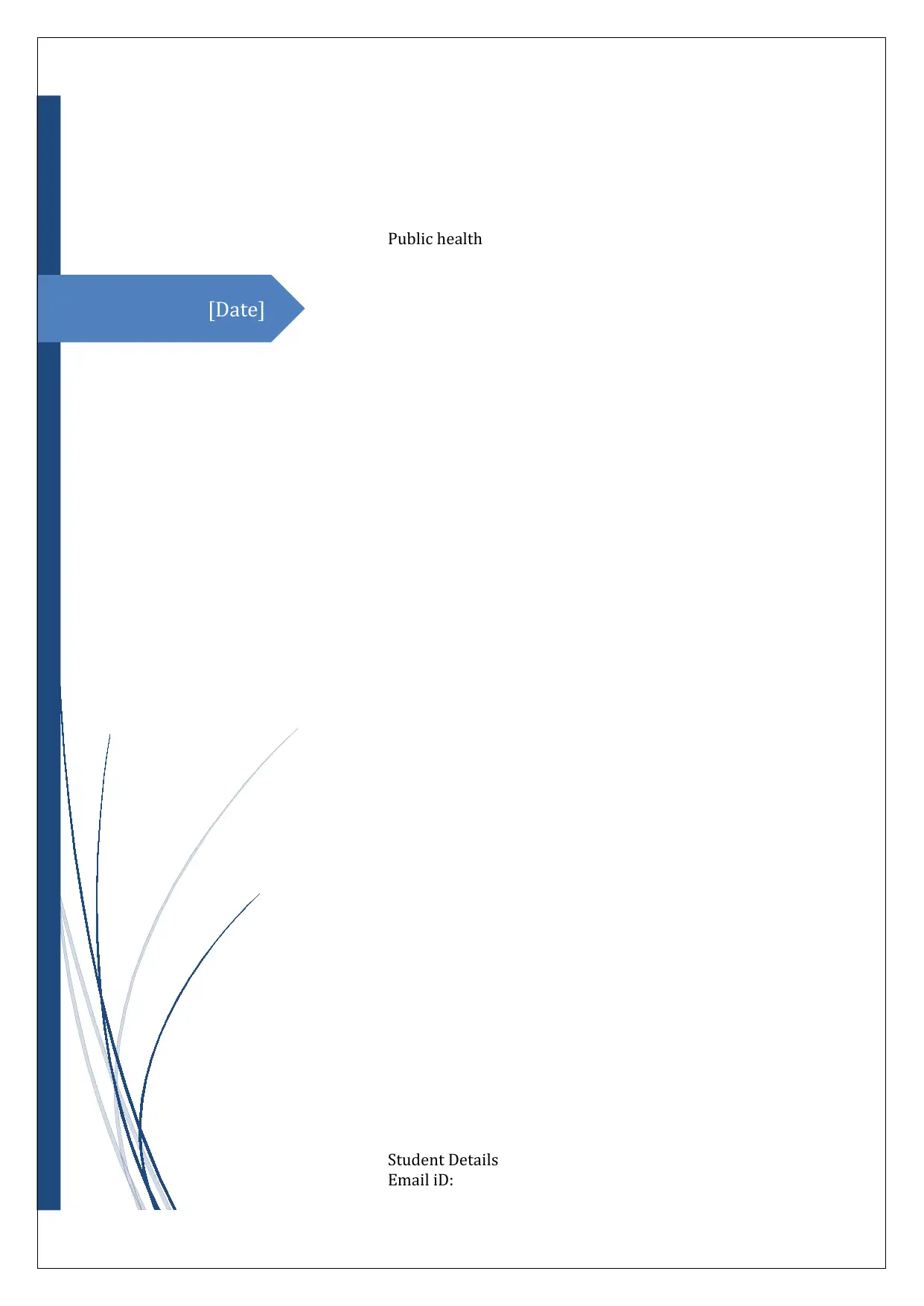
[Date]
Public health
Student Details
Email iD:
Public health
Student Details
Email iD:
Secure Best Marks with AI Grader
Need help grading? Try our AI Grader for instant feedback on your assignments.
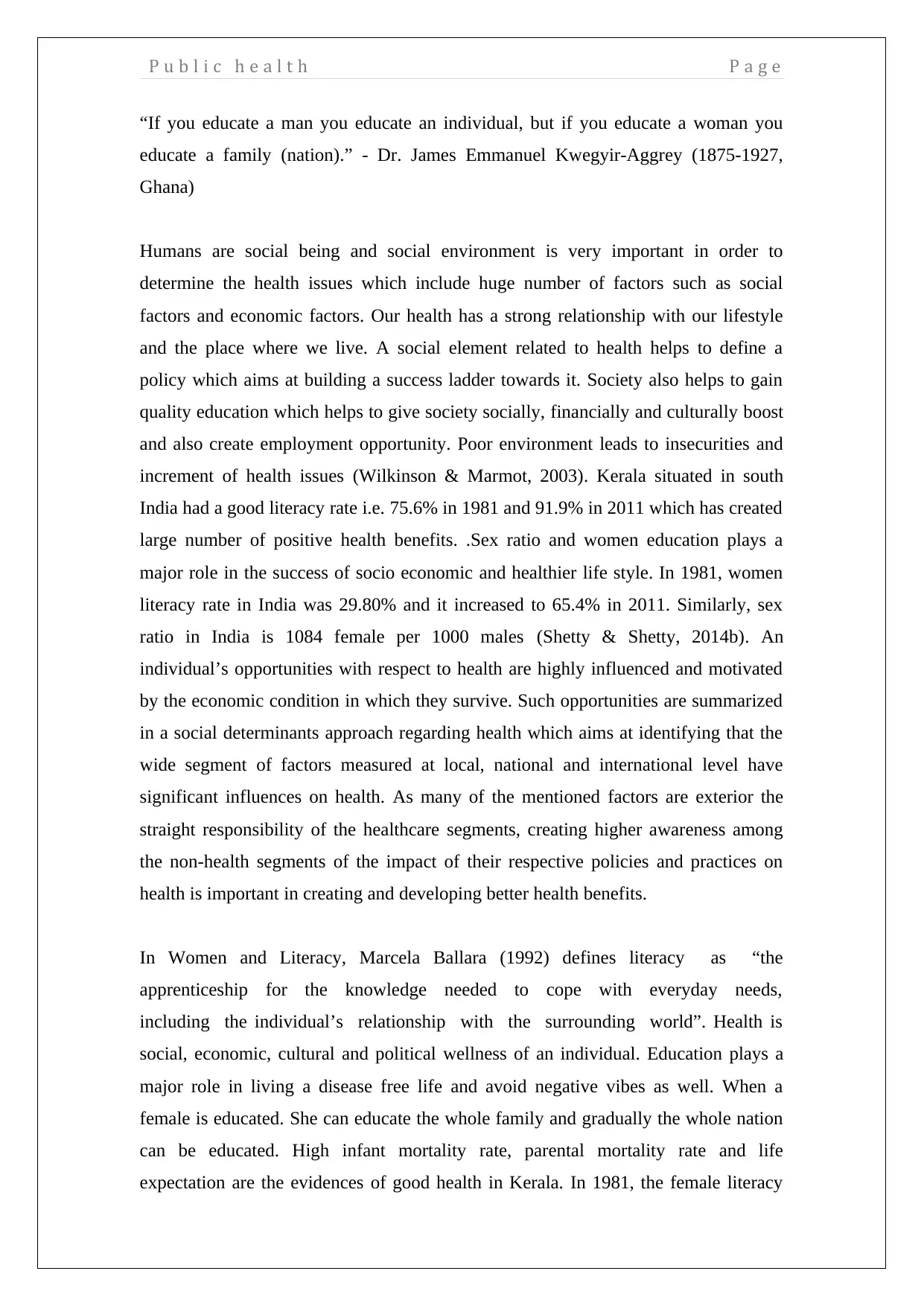
P u b l i c h e a l t h P a g e
“If you educate a man you educate an individual, but if you educate a woman you
educate a family (nation).” - Dr. James Emmanuel Kwegyir-Aggrey (1875-1927,
Ghana)
Humans are social being and social environment is very important in order to
determine the health issues which include huge number of factors such as social
factors and economic factors. Our health has a strong relationship with our lifestyle
and the place where we live. A social element related to health helps to define a
policy which aims at building a success ladder towards it. Society also helps to gain
quality education which helps to give society socially, financially and culturally boost
and also create employment opportunity. Poor environment leads to insecurities and
increment of health issues (Wilkinson & Marmot, 2003). Kerala situated in south
India had a good literacy rate i.e. 75.6% in 1981 and 91.9% in 2011 which has created
large number of positive health benefits. .Sex ratio and women education plays a
major role in the success of socio economic and healthier life style. In 1981, women
literacy rate in India was 29.80% and it increased to 65.4% in 2011. Similarly, sex
ratio in India is 1084 female per 1000 males (Shetty & Shetty, 2014b). An
individual’s opportunities with respect to health are highly influenced and motivated
by the economic condition in which they survive. Such opportunities are summarized
in a social determinants approach regarding health which aims at identifying that the
wide segment of factors measured at local, national and international level have
significant influences on health. As many of the mentioned factors are exterior the
straight responsibility of the healthcare segments, creating higher awareness among
the non-health segments of the impact of their respective policies and practices on
health is important in creating and developing better health benefits.
In Women and Literacy, Marcela Ballara (1992) defines literacy as “the
apprenticeship for the knowledge needed to cope with everyday needs,
including the individual’s relationship with the surrounding world”. Health is
social, economic, cultural and political wellness of an individual. Education plays a
major role in living a disease free life and avoid negative vibes as well. When a
female is educated. She can educate the whole family and gradually the whole nation
can be educated. High infant mortality rate, parental mortality rate and life
expectation are the evidences of good health in Kerala. In 1981, the female literacy
“If you educate a man you educate an individual, but if you educate a woman you
educate a family (nation).” - Dr. James Emmanuel Kwegyir-Aggrey (1875-1927,
Ghana)
Humans are social being and social environment is very important in order to
determine the health issues which include huge number of factors such as social
factors and economic factors. Our health has a strong relationship with our lifestyle
and the place where we live. A social element related to health helps to define a
policy which aims at building a success ladder towards it. Society also helps to gain
quality education which helps to give society socially, financially and culturally boost
and also create employment opportunity. Poor environment leads to insecurities and
increment of health issues (Wilkinson & Marmot, 2003). Kerala situated in south
India had a good literacy rate i.e. 75.6% in 1981 and 91.9% in 2011 which has created
large number of positive health benefits. .Sex ratio and women education plays a
major role in the success of socio economic and healthier life style. In 1981, women
literacy rate in India was 29.80% and it increased to 65.4% in 2011. Similarly, sex
ratio in India is 1084 female per 1000 males (Shetty & Shetty, 2014b). An
individual’s opportunities with respect to health are highly influenced and motivated
by the economic condition in which they survive. Such opportunities are summarized
in a social determinants approach regarding health which aims at identifying that the
wide segment of factors measured at local, national and international level have
significant influences on health. As many of the mentioned factors are exterior the
straight responsibility of the healthcare segments, creating higher awareness among
the non-health segments of the impact of their respective policies and practices on
health is important in creating and developing better health benefits.
In Women and Literacy, Marcela Ballara (1992) defines literacy as “the
apprenticeship for the knowledge needed to cope with everyday needs,
including the individual’s relationship with the surrounding world”. Health is
social, economic, cultural and political wellness of an individual. Education plays a
major role in living a disease free life and avoid negative vibes as well. When a
female is educated. She can educate the whole family and gradually the whole nation
can be educated. High infant mortality rate, parental mortality rate and life
expectation are the evidences of good health in Kerala. In 1981, the female literacy
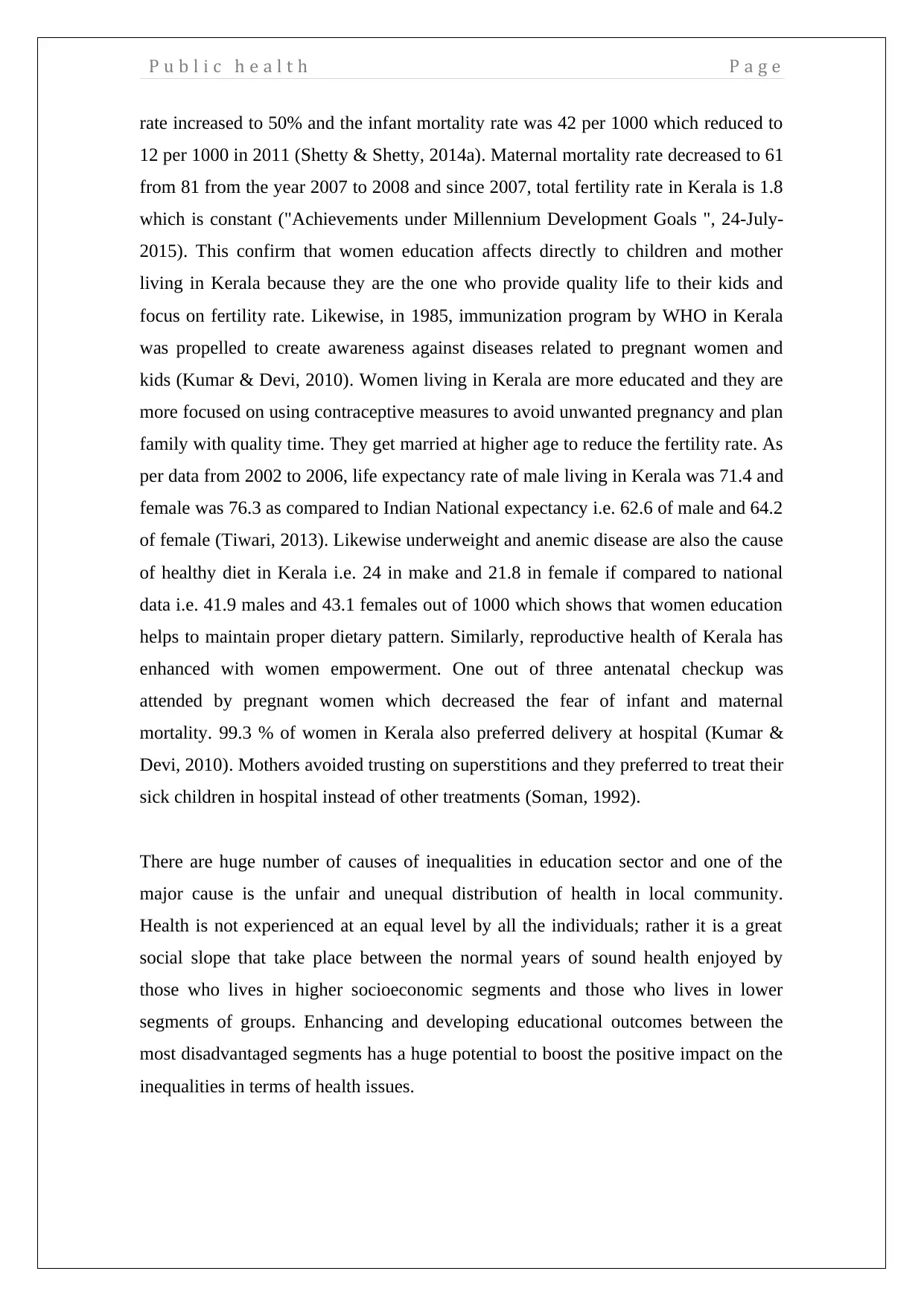
P u b l i c h e a l t h P a g e
rate increased to 50% and the infant mortality rate was 42 per 1000 which reduced to
12 per 1000 in 2011 (Shetty & Shetty, 2014a). Maternal mortality rate decreased to 61
from 81 from the year 2007 to 2008 and since 2007, total fertility rate in Kerala is 1.8
which is constant ("Achievements under Millennium Development Goals ", 24-July-
2015). This confirm that women education affects directly to children and mother
living in Kerala because they are the one who provide quality life to their kids and
focus on fertility rate. Likewise, in 1985, immunization program by WHO in Kerala
was propelled to create awareness against diseases related to pregnant women and
kids (Kumar & Devi, 2010). Women living in Kerala are more educated and they are
more focused on using contraceptive measures to avoid unwanted pregnancy and plan
family with quality time. They get married at higher age to reduce the fertility rate. As
per data from 2002 to 2006, life expectancy rate of male living in Kerala was 71.4 and
female was 76.3 as compared to Indian National expectancy i.e. 62.6 of male and 64.2
of female (Tiwari, 2013). Likewise underweight and anemic disease are also the cause
of healthy diet in Kerala i.e. 24 in make and 21.8 in female if compared to national
data i.e. 41.9 males and 43.1 females out of 1000 which shows that women education
helps to maintain proper dietary pattern. Similarly, reproductive health of Kerala has
enhanced with women empowerment. One out of three antenatal checkup was
attended by pregnant women which decreased the fear of infant and maternal
mortality. 99.3 % of women in Kerala also preferred delivery at hospital (Kumar &
Devi, 2010). Mothers avoided trusting on superstitions and they preferred to treat their
sick children in hospital instead of other treatments (Soman, 1992).
There are huge number of causes of inequalities in education sector and one of the
major cause is the unfair and unequal distribution of health in local community.
Health is not experienced at an equal level by all the individuals; rather it is a great
social slope that take place between the normal years of sound health enjoyed by
those who lives in higher socioeconomic segments and those who lives in lower
segments of groups. Enhancing and developing educational outcomes between the
most disadvantaged segments has a huge potential to boost the positive impact on the
inequalities in terms of health issues.
rate increased to 50% and the infant mortality rate was 42 per 1000 which reduced to
12 per 1000 in 2011 (Shetty & Shetty, 2014a). Maternal mortality rate decreased to 61
from 81 from the year 2007 to 2008 and since 2007, total fertility rate in Kerala is 1.8
which is constant ("Achievements under Millennium Development Goals ", 24-July-
2015). This confirm that women education affects directly to children and mother
living in Kerala because they are the one who provide quality life to their kids and
focus on fertility rate. Likewise, in 1985, immunization program by WHO in Kerala
was propelled to create awareness against diseases related to pregnant women and
kids (Kumar & Devi, 2010). Women living in Kerala are more educated and they are
more focused on using contraceptive measures to avoid unwanted pregnancy and plan
family with quality time. They get married at higher age to reduce the fertility rate. As
per data from 2002 to 2006, life expectancy rate of male living in Kerala was 71.4 and
female was 76.3 as compared to Indian National expectancy i.e. 62.6 of male and 64.2
of female (Tiwari, 2013). Likewise underweight and anemic disease are also the cause
of healthy diet in Kerala i.e. 24 in make and 21.8 in female if compared to national
data i.e. 41.9 males and 43.1 females out of 1000 which shows that women education
helps to maintain proper dietary pattern. Similarly, reproductive health of Kerala has
enhanced with women empowerment. One out of three antenatal checkup was
attended by pregnant women which decreased the fear of infant and maternal
mortality. 99.3 % of women in Kerala also preferred delivery at hospital (Kumar &
Devi, 2010). Mothers avoided trusting on superstitions and they preferred to treat their
sick children in hospital instead of other treatments (Soman, 1992).
There are huge number of causes of inequalities in education sector and one of the
major cause is the unfair and unequal distribution of health in local community.
Health is not experienced at an equal level by all the individuals; rather it is a great
social slope that take place between the normal years of sound health enjoyed by
those who lives in higher socioeconomic segments and those who lives in lower
segments of groups. Enhancing and developing educational outcomes between the
most disadvantaged segments has a huge potential to boost the positive impact on the
inequalities in terms of health issues.
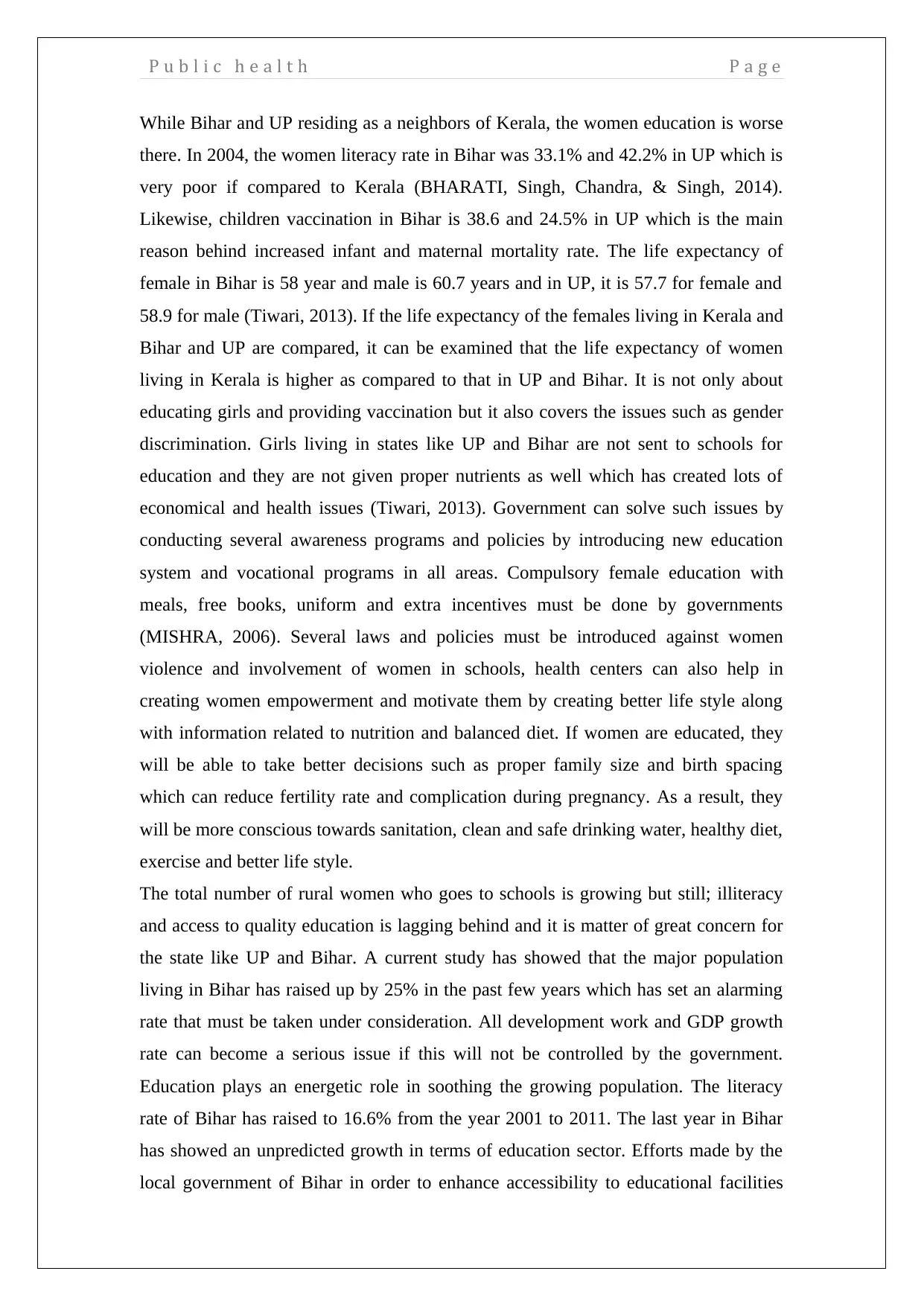
P u b l i c h e a l t h P a g e
While Bihar and UP residing as a neighbors of Kerala, the women education is worse
there. In 2004, the women literacy rate in Bihar was 33.1% and 42.2% in UP which is
very poor if compared to Kerala (BHARATI, Singh, Chandra, & Singh, 2014).
Likewise, children vaccination in Bihar is 38.6 and 24.5% in UP which is the main
reason behind increased infant and maternal mortality rate. The life expectancy of
female in Bihar is 58 year and male is 60.7 years and in UP, it is 57.7 for female and
58.9 for male (Tiwari, 2013). If the life expectancy of the females living in Kerala and
Bihar and UP are compared, it can be examined that the life expectancy of women
living in Kerala is higher as compared to that in UP and Bihar. It is not only about
educating girls and providing vaccination but it also covers the issues such as gender
discrimination. Girls living in states like UP and Bihar are not sent to schools for
education and they are not given proper nutrients as well which has created lots of
economical and health issues (Tiwari, 2013). Government can solve such issues by
conducting several awareness programs and policies by introducing new education
system and vocational programs in all areas. Compulsory female education with
meals, free books, uniform and extra incentives must be done by governments
(MISHRA, 2006). Several laws and policies must be introduced against women
violence and involvement of women in schools, health centers can also help in
creating women empowerment and motivate them by creating better life style along
with information related to nutrition and balanced diet. If women are educated, they
will be able to take better decisions such as proper family size and birth spacing
which can reduce fertility rate and complication during pregnancy. As a result, they
will be more conscious towards sanitation, clean and safe drinking water, healthy diet,
exercise and better life style.
The total number of rural women who goes to schools is growing but still; illiteracy
and access to quality education is lagging behind and it is matter of great concern for
the state like UP and Bihar. A current study has showed that the major population
living in Bihar has raised up by 25% in the past few years which has set an alarming
rate that must be taken under consideration. All development work and GDP growth
rate can become a serious issue if this will not be controlled by the government.
Education plays an energetic role in soothing the growing population. The literacy
rate of Bihar has raised to 16.6% from the year 2001 to 2011. The last year in Bihar
has showed an unpredicted growth in terms of education sector. Efforts made by the
local government of Bihar in order to enhance accessibility to educational facilities
While Bihar and UP residing as a neighbors of Kerala, the women education is worse
there. In 2004, the women literacy rate in Bihar was 33.1% and 42.2% in UP which is
very poor if compared to Kerala (BHARATI, Singh, Chandra, & Singh, 2014).
Likewise, children vaccination in Bihar is 38.6 and 24.5% in UP which is the main
reason behind increased infant and maternal mortality rate. The life expectancy of
female in Bihar is 58 year and male is 60.7 years and in UP, it is 57.7 for female and
58.9 for male (Tiwari, 2013). If the life expectancy of the females living in Kerala and
Bihar and UP are compared, it can be examined that the life expectancy of women
living in Kerala is higher as compared to that in UP and Bihar. It is not only about
educating girls and providing vaccination but it also covers the issues such as gender
discrimination. Girls living in states like UP and Bihar are not sent to schools for
education and they are not given proper nutrients as well which has created lots of
economical and health issues (Tiwari, 2013). Government can solve such issues by
conducting several awareness programs and policies by introducing new education
system and vocational programs in all areas. Compulsory female education with
meals, free books, uniform and extra incentives must be done by governments
(MISHRA, 2006). Several laws and policies must be introduced against women
violence and involvement of women in schools, health centers can also help in
creating women empowerment and motivate them by creating better life style along
with information related to nutrition and balanced diet. If women are educated, they
will be able to take better decisions such as proper family size and birth spacing
which can reduce fertility rate and complication during pregnancy. As a result, they
will be more conscious towards sanitation, clean and safe drinking water, healthy diet,
exercise and better life style.
The total number of rural women who goes to schools is growing but still; illiteracy
and access to quality education is lagging behind and it is matter of great concern for
the state like UP and Bihar. A current study has showed that the major population
living in Bihar has raised up by 25% in the past few years which has set an alarming
rate that must be taken under consideration. All development work and GDP growth
rate can become a serious issue if this will not be controlled by the government.
Education plays an energetic role in soothing the growing population. The literacy
rate of Bihar has raised to 16.6% from the year 2001 to 2011. The last year in Bihar
has showed an unpredicted growth in terms of education sector. Efforts made by the
local government of Bihar in order to enhance accessibility to educational facilities
Secure Best Marks with AI Grader
Need help grading? Try our AI Grader for instant feedback on your assignments.
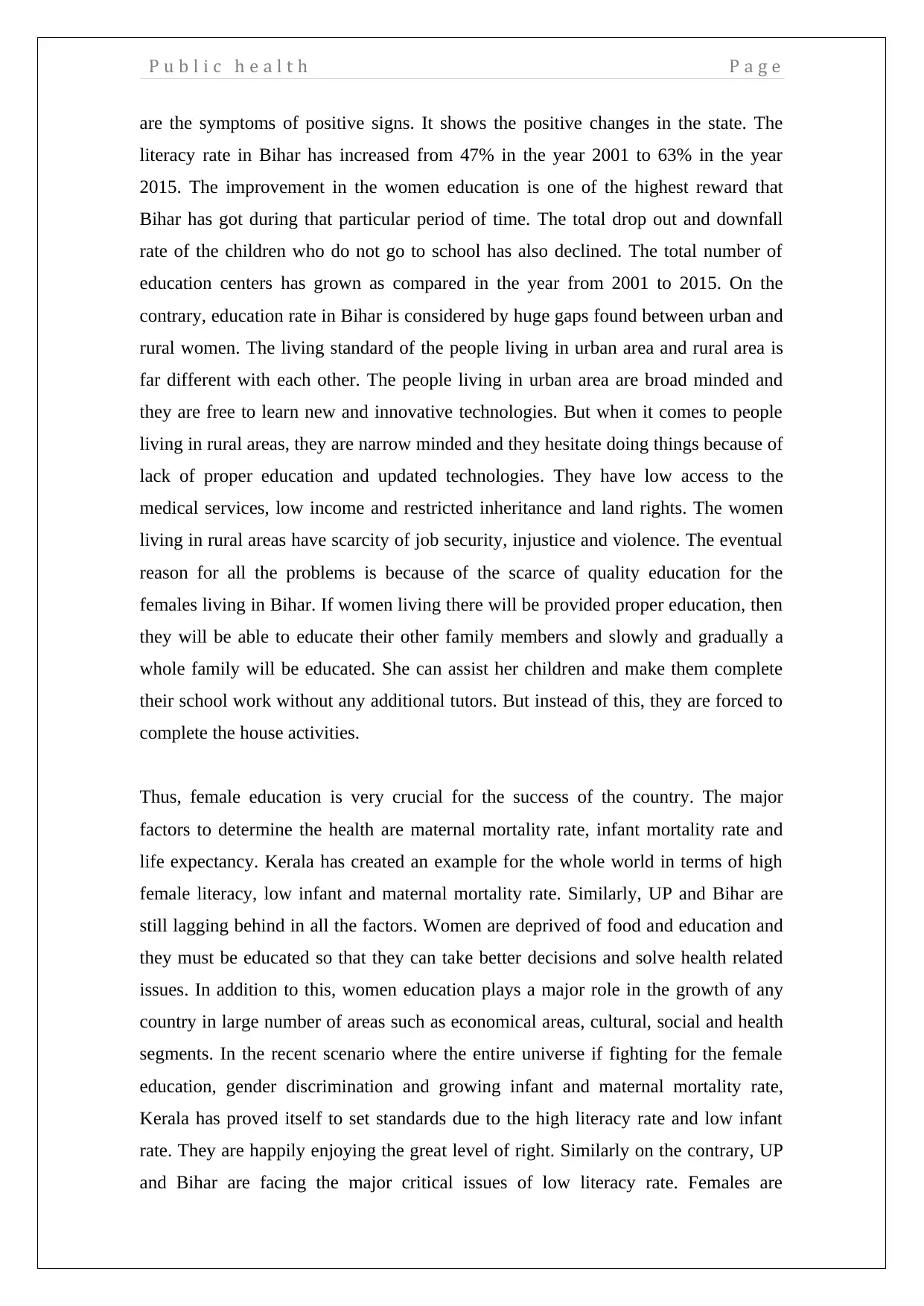
P u b l i c h e a l t h P a g e
are the symptoms of positive signs. It shows the positive changes in the state. The
literacy rate in Bihar has increased from 47% in the year 2001 to 63% in the year
2015. The improvement in the women education is one of the highest reward that
Bihar has got during that particular period of time. The total drop out and downfall
rate of the children who do not go to school has also declined. The total number of
education centers has grown as compared in the year from 2001 to 2015. On the
contrary, education rate in Bihar is considered by huge gaps found between urban and
rural women. The living standard of the people living in urban area and rural area is
far different with each other. The people living in urban area are broad minded and
they are free to learn new and innovative technologies. But when it comes to people
living in rural areas, they are narrow minded and they hesitate doing things because of
lack of proper education and updated technologies. They have low access to the
medical services, low income and restricted inheritance and land rights. The women
living in rural areas have scarcity of job security, injustice and violence. The eventual
reason for all the problems is because of the scarce of quality education for the
females living in Bihar. If women living there will be provided proper education, then
they will be able to educate their other family members and slowly and gradually a
whole family will be educated. She can assist her children and make them complete
their school work without any additional tutors. But instead of this, they are forced to
complete the house activities.
Thus, female education is very crucial for the success of the country. The major
factors to determine the health are maternal mortality rate, infant mortality rate and
life expectancy. Kerala has created an example for the whole world in terms of high
female literacy, low infant and maternal mortality rate. Similarly, UP and Bihar are
still lagging behind in all the factors. Women are deprived of food and education and
they must be educated so that they can take better decisions and solve health related
issues. In addition to this, women education plays a major role in the growth of any
country in large number of areas such as economical areas, cultural, social and health
segments. In the recent scenario where the entire universe if fighting for the female
education, gender discrimination and growing infant and maternal mortality rate,
Kerala has proved itself to set standards due to the high literacy rate and low infant
rate. They are happily enjoying the great level of right. Similarly on the contrary, UP
and Bihar are facing the major critical issues of low literacy rate. Females are
are the symptoms of positive signs. It shows the positive changes in the state. The
literacy rate in Bihar has increased from 47% in the year 2001 to 63% in the year
2015. The improvement in the women education is one of the highest reward that
Bihar has got during that particular period of time. The total drop out and downfall
rate of the children who do not go to school has also declined. The total number of
education centers has grown as compared in the year from 2001 to 2015. On the
contrary, education rate in Bihar is considered by huge gaps found between urban and
rural women. The living standard of the people living in urban area and rural area is
far different with each other. The people living in urban area are broad minded and
they are free to learn new and innovative technologies. But when it comes to people
living in rural areas, they are narrow minded and they hesitate doing things because of
lack of proper education and updated technologies. They have low access to the
medical services, low income and restricted inheritance and land rights. The women
living in rural areas have scarcity of job security, injustice and violence. The eventual
reason for all the problems is because of the scarce of quality education for the
females living in Bihar. If women living there will be provided proper education, then
they will be able to educate their other family members and slowly and gradually a
whole family will be educated. She can assist her children and make them complete
their school work without any additional tutors. But instead of this, they are forced to
complete the house activities.
Thus, female education is very crucial for the success of the country. The major
factors to determine the health are maternal mortality rate, infant mortality rate and
life expectancy. Kerala has created an example for the whole world in terms of high
female literacy, low infant and maternal mortality rate. Similarly, UP and Bihar are
still lagging behind in all the factors. Women are deprived of food and education and
they must be educated so that they can take better decisions and solve health related
issues. In addition to this, women education plays a major role in the growth of any
country in large number of areas such as economical areas, cultural, social and health
segments. In the recent scenario where the entire universe if fighting for the female
education, gender discrimination and growing infant and maternal mortality rate,
Kerala has proved itself to set standards due to the high literacy rate and low infant
rate. They are happily enjoying the great level of right. Similarly on the contrary, UP
and Bihar are facing the major critical issues of low literacy rate. Females are
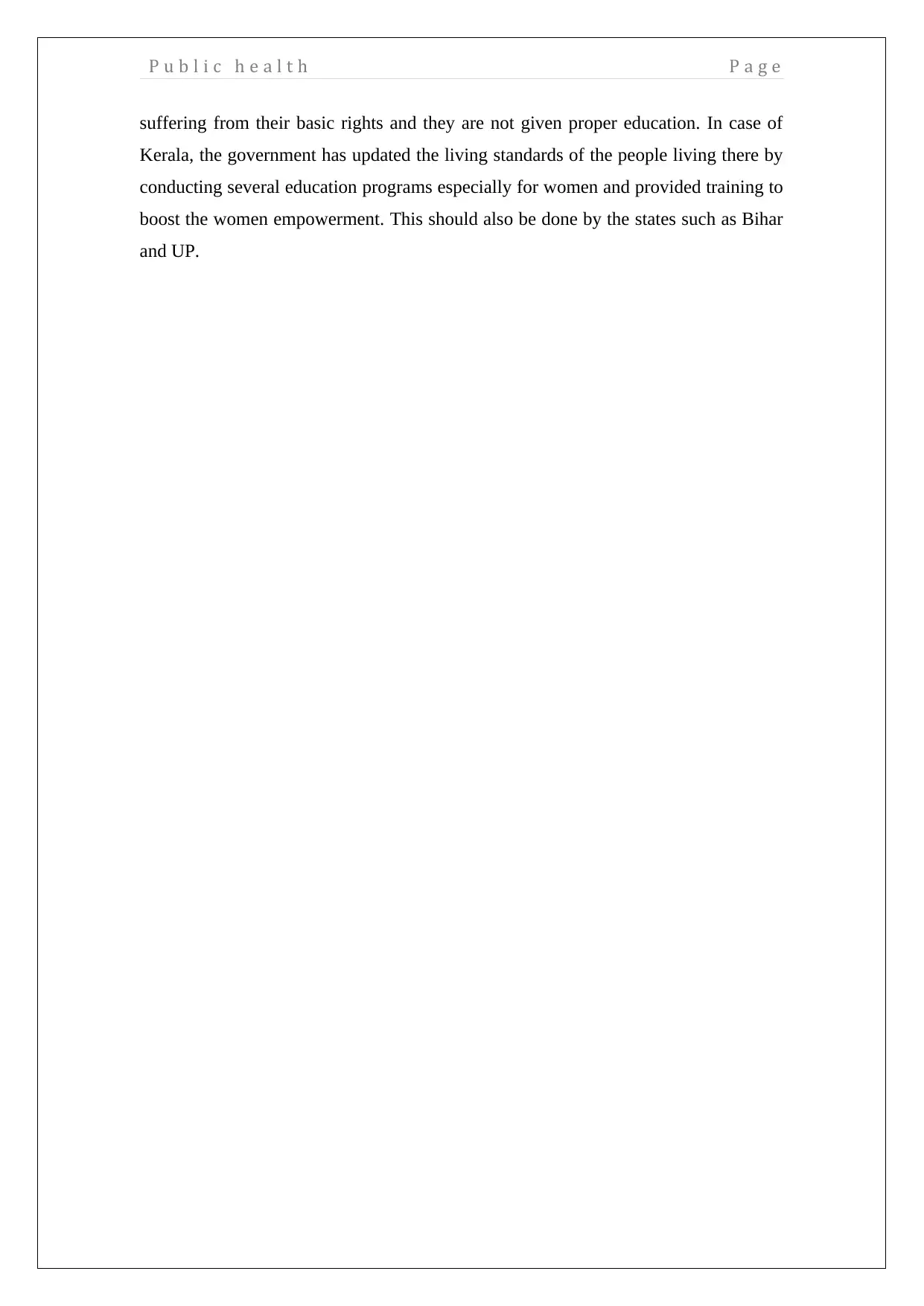
P u b l i c h e a l t h P a g e
suffering from their basic rights and they are not given proper education. In case of
Kerala, the government has updated the living standards of the people living there by
conducting several education programs especially for women and provided training to
boost the women empowerment. This should also be done by the states such as Bihar
and UP.
suffering from their basic rights and they are not given proper education. In case of
Kerala, the government has updated the living standards of the people living there by
conducting several education programs especially for women and provided training to
boost the women empowerment. This should also be done by the states such as Bihar
and UP.
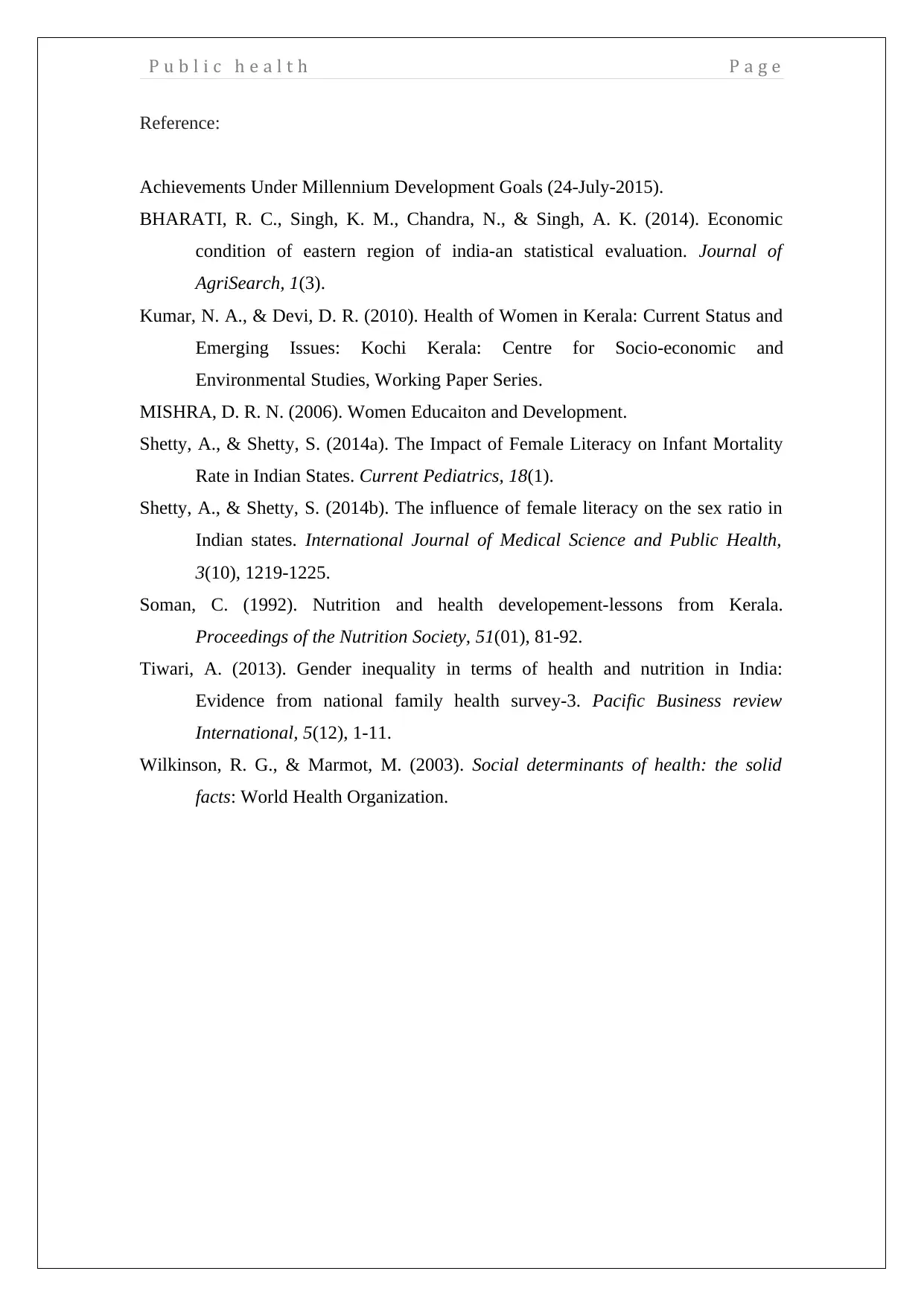
P u b l i c h e a l t h P a g e
Reference:
Achievements Under Millennium Development Goals (24-July-2015).
BHARATI, R. C., Singh, K. M., Chandra, N., & Singh, A. K. (2014). Economic
condition of eastern region of india-an statistical evaluation. Journal of
AgriSearch, 1(3).
Kumar, N. A., & Devi, D. R. (2010). Health of Women in Kerala: Current Status and
Emerging Issues: Kochi Kerala: Centre for Socio-economic and
Environmental Studies, Working Paper Series.
MISHRA, D. R. N. (2006). Women Educaiton and Development.
Shetty, A., & Shetty, S. (2014a). The Impact of Female Literacy on Infant Mortality
Rate in Indian States. Current Pediatrics, 18(1).
Shetty, A., & Shetty, S. (2014b). The influence of female literacy on the sex ratio in
Indian states. International Journal of Medical Science and Public Health,
3(10), 1219-1225.
Soman, C. (1992). Nutrition and health developement-lessons from Kerala.
Proceedings of the Nutrition Society, 51(01), 81-92.
Tiwari, A. (2013). Gender inequality in terms of health and nutrition in India:
Evidence from national family health survey-3. Pacific Business review
International, 5(12), 1-11.
Wilkinson, R. G., & Marmot, M. (2003). Social determinants of health: the solid
facts: World Health Organization.
Reference:
Achievements Under Millennium Development Goals (24-July-2015).
BHARATI, R. C., Singh, K. M., Chandra, N., & Singh, A. K. (2014). Economic
condition of eastern region of india-an statistical evaluation. Journal of
AgriSearch, 1(3).
Kumar, N. A., & Devi, D. R. (2010). Health of Women in Kerala: Current Status and
Emerging Issues: Kochi Kerala: Centre for Socio-economic and
Environmental Studies, Working Paper Series.
MISHRA, D. R. N. (2006). Women Educaiton and Development.
Shetty, A., & Shetty, S. (2014a). The Impact of Female Literacy on Infant Mortality
Rate in Indian States. Current Pediatrics, 18(1).
Shetty, A., & Shetty, S. (2014b). The influence of female literacy on the sex ratio in
Indian states. International Journal of Medical Science and Public Health,
3(10), 1219-1225.
Soman, C. (1992). Nutrition and health developement-lessons from Kerala.
Proceedings of the Nutrition Society, 51(01), 81-92.
Tiwari, A. (2013). Gender inequality in terms of health and nutrition in India:
Evidence from national family health survey-3. Pacific Business review
International, 5(12), 1-11.
Wilkinson, R. G., & Marmot, M. (2003). Social determinants of health: the solid
facts: World Health Organization.
1 out of 7
Related Documents
Your All-in-One AI-Powered Toolkit for Academic Success.
+13062052269
info@desklib.com
Available 24*7 on WhatsApp / Email
![[object Object]](/_next/static/media/star-bottom.7253800d.svg)
Unlock your academic potential
© 2024 | Zucol Services PVT LTD | All rights reserved.





